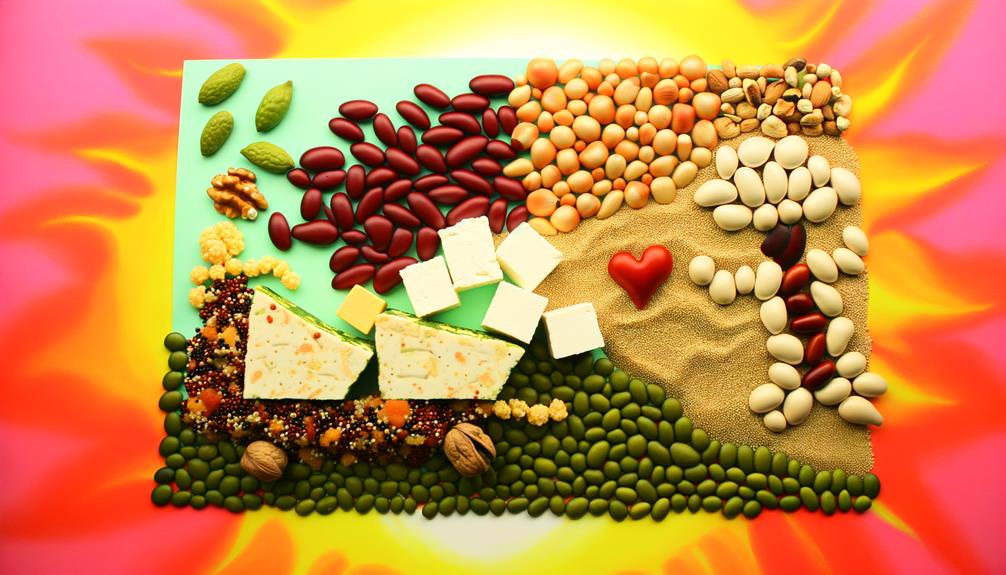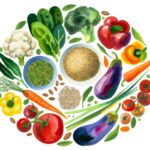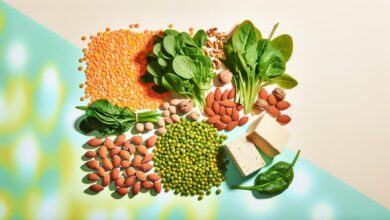Imagine a vibrant tapestry of greens, grains, and legumes strewn across your kitchen counter, each component a building block for your child’s growth and vitality. As you seek to nourish your little ones with the best that nature offers, it’s essential to explore the bountiful array of plant-based proteins that are not only kind to the planet but also to their developing bodies. You’re conscientiously crafting meals that are as rich in culture as they are in nutrients, weaving compassion into every bite. In this culinary journey, you’ll find that lentils and chickpeas become more than just ingredients; they transform into the heroes of hearty stews and dips. Quinoa, with its subtle nutty essence, serves as a versatile foundation for both sweet and savory dishes. And as you introduce tofu and leafy greens onto their plates, you’re also sowing seeds for lifelong healthy eating habits. But the list doesn’t end here; there are more wholesome foods waiting to enrich your family’s diet, each with its own story to tell and benefits to offer. Let’s uncover these nutritional treasures together, and you’ll see just how satisfying and delicious plant-based eating for kids can be.
Key Takeaways
- Lentils and legumes are nutritious and affordable options for kids, providing them with protein, fiber, vitamins, and minerals.
- Chickpeas offer essential nutrients and flavors, and can be enjoyed in various forms such as hummus, salads, roasted snacks, and soups.
- Quinoa is a nutrient-dense ancient grain that comes in different varieties like white, red, and black, adding taste and texture to dishes like stews, toasts, and salads.
- Tofu and tempeh are plant-based protein sources that provide important nutrients like calcium, iron, and dietary fiber, and can be used in a variety of cuisines and recipes.
Lentils and Legumes
While often overlooked, lentils and legumes are nutritional powerhouses that can play a vital role in your child’s diet, offering an abundance of protein essential for their growth and development. These humble foods, steeped in cultural significance, are not just economical; they’re also rich in fiber, vitamins, and minerals, supporting a healthy and balanced lifestyle for your little ones.
You can introduce lentil soups as a warming and nourishing meal, perfect for those chilly evenings when your family gathers around the table. Infused with aromatic spices and vegetables, lentil soups are both comforting and culturally enriching, allowing you to pass on traditions through flavors and stories.
Bean burgers are another delightful way to serve up legumes; they’re not only fun and tasty but also packed with goodness. These burgers provide a creative and enjoyable approach for kids to love their legumes, and they’re fantastic for those days when you’re seeking a meal that’s both satisfying and beneficial for your child’s well-being.
Embrace the versatility of lentils and legumes. They’re more than just food; they’re a compassionate choice that nurtures your child and serves the greater good, one wholesome bite at a time.
Chickpeas and Hummus
Chickpeas, often a staple in many cultural kitchens, serve as both a delicious and nutritious addition to your child’s diet, with hummus being a creamy and versatile way to enjoy this protein-rich legume. Packed with essential nutrients, chickpeas offer a symphony of health benefits and flavors that can delight young palates while nurturing growing bodies. Let’s explore how you can incorporate these gems into your family meals.
- Hummus Dip: A smooth blend of chickpeas, tahini, olive oil, and spices, perfect for dipping veggies or spreading on whole-grain bread.
- Garbanzo Salad: Toss chickpeas with fresh vegetables, a zesty dressing, and herbs for a satisfying and colorful meal.
- Roasted Chickpeas: A crunchy, fiber-rich snack that’s customizable with your favorite seasonings.
- Chickpea Soup: A comforting and hearty option for colder days, full of protein and flavor.
- Chickpea Pancakes: A protein-packed breakfast twist that’s both filling and fun for kids.
Quinoa Varieties
Just as chickpeas offer a versatile foundation for numerous dishes, quinoa stands out as another nutrient-dense option that comes in a variety of forms to suit any meal. You’ll find that quinoa, a treasured ancient grain, is not only rich in protein but also culturally significant, revered by the Incas as the “mother of all grains.” Its gentle, nurturing nature makes it perfect for your family’s table, where nourishment and care come first.
Quinoa comes in multiple varieties, such as white, red, and black, each with its subtle taste and texture differences. White quinoa, often the most common, has a mildly nutty flavor and fluffs up beautifully when cooked, making it a fantastic addition to your children’s favorite quinoa salads. Red quinoa holds its shape better, providing a pleasing crunch, which is excellent for adding depth to dishes. Black quinoa, on the other hand, has an earthier taste and makes for a visually striking component in meals.
Different cooking methods can enhance quinoa’s versatility. Whether you’re simmering it as a base for a hearty stew, toasting it for a crunchy snack, or folding it into a cold salad, each method brings out a unique character in quinoa. It’s a compassionate way to honor the world’s cultures, serving a grain that’s as good for the body as it is for the soul.
Tofu and Tempeh
Moving beyond grains, tofu and tempeh stand as pillars of plant-based protein, offering a cultural bridge to nutritious meals that both satisfy and nurture growing children. Tofu, a soybean curd, is not only versatile in Tofu recipes but also rich in calcium and iron, which are crucial for bone and blood health. Tempeh, a fermented soy product, introduces a unique texture and a slight nutty flavor to your family’s diet, along with a boost of dietary fiber that aids digestion.
Here’s why you should consider incorporating tofu and tempeh into your kids’ meals:
- Rich in Essential Amino Acids: Complete proteins that support growth and development.
- High in Nutrients: Soybean benefits include vitamins and minerals such as magnesium, potassium, and zinc.
- Versatile Food Options: Easily adaptable to various cuisines and Tofu recipes.
- Digestive Health Support: Tempeh’s fermentation process promotes a healthy gut.
- Sustainable Protein Source: A compassionate choice, lessening the environmental impact.
Embracing these soy-based foods not only nourishes your children but also teaches them the importance of cultural diversity and compassion through their diet. Your dedication to serving others starts with what you put on the plate, making tofu and tempeh excellent choices for a harmonious and healthful family meal.
Nutritional Yeast
While exploring the bounty of plant-based proteins, don’t overlook nutritional yeast, a savory addition to your child’s diet that’s packed with B-vitamins and protein. This unique food not only offers a cheese-like flavor enhancement to various dishes but also provides significant nutritional benefits.
Nutritional yeast, a deactivated yeast, is a powerhouse of nutrients. It’s a complete protein, providing all nine essential amino acids that your child needs for growth and repair. You’ll be nurturing their body with a wealth of B-vitamins, which are vital for energy production and cognitive development. It’s also fortified with vitamin B12, often a concern in plant-based diets, supporting nerve function and the formation of red blood cells.
You can sprinkle it on pasta, mix it into soups, or even use it to create delectable vegan cheeses. Its versatility in the kitchen allows you to enhance meals with both nutrition and taste, without compromising on your cultural values of compassion and care.
Plant-Based Milks
You’ll find that plant-based milks offer a delightful and nutritious alternative to dairy, rich in essential nutrients tailored for a growing child’s needs. Whether you’re nurturing a little one with allergies or simply choosing a compassionate lifestyle, these milk substitutes are both kind and nourishing.
Consider these inviting options that are both allergy-friendly and brimming with goodness:
- Almond milk: A heart-healthy choice, often fortified with calcium and vitamin D.
- Soy milk: Packed with protein, mirroring the nutrient profile of cow’s milk.
- Oat milk: High in fiber and a creamy addition to any plant-based milkshake.
- Coconut milk: Offers a tropical twist and healthy fats, perfect for smoothies.
- Rice milk: The most hypoallergenic, it’s a safe bet for kids with multiple allergies.
These milk alternatives can seamlessly integrate into your family’s meals. Imagine the joy of serving up frothy plant-based milkshakes, knowing you’re providing your child with the sustenance they require in a form they’ll adore. By embracing these allergy-friendly alternatives, you’re making a choice that’s as kind to your child’s body as it is to the world they’ll inherit.
Hemp and Chia Seeds
As we explore the vast garden of plant-based nourishment, let’s not overlook the mighty benefits of hemp and chia seeds, which are tiny powerhouses of protein essential for your child’s growth. These seeds are more than just add-ons; they are the epitome of seed nutrition, offering a wealth of amino acids, fatty acids, vitamins, and minerals that can significantly contribute to a balanced diet.
You can weave these seeds into your family’s meals with creative incorporations that go far beyond the typical sprinkle on a salad. Imagine starting your little one’s day with a smoothie enriched with chia, or hemp seeds blended into homemade granola bars. These subtle yet potent additions provide a protein boost that supports muscle development and overall well-being.
In a world where we strive to serve others and share the richness of diverse cultures, introducing hemp and chia seeds to your child’s palate can be a compassionate step towards fostering a love for nutritious, global cuisine. By embracing the full spectrum of plant-based foods, you’re not only nurturing your child’s body but also sowing seeds of awareness and appreciation for Earth’s bounty.
Green Peas
Embarking on the green journey of plant-based eating, let’s turn our attention to green peas, a humble yet mighty source of protein that can play a pivotal role in your child’s healthy diet. These vibrant spheres are not only packed with pea protein but also embody a tradition of nurturing and care through food that spans cultures worldwide.
Green peas are like little gems bestowing their nutritious wealth upon us, and here’s why they’re invaluable in your little one’s meals:
- Rich in Protein: A cup of peas contains about 8 grams of pea protein, important for growth and repair.
- Vitamin Powerhouse: Abundant in vitamins A, C, K, and B vitamins, they support a thriving young body.
- Mineral-Rich: They offer iron, magnesium, and potassium, which are essential for a healthy heart and strong muscles.
- Fiber-Filled: Great for digestion, peas can help keep your child’s tummy happy.
- Versatile: Easily incorporated into various dishes, from pea soups to purees, making mealtime both fun and nutritious.
Edamame Snacks
Continuing our exploration of protein-packed plants, let’s consider edamame, a snack that’s as fun to pop out of its pod as it is beneficial for your child’s growth and development. These young soybeans are harvested before they harden, offering a tender, buttery bite that’s rich in protein and other nutrients essential for your little one’s well-being.
To make edamame even more enticing, why not whip up some edamame dips? They’re a fantastic way to introduce your kids to the joy of healthy eating while engaging in the cultural practice of sharing food. Blending edamame with herbs and spices can yield a dip that’s both flavorful and packed with soybean benefits.
Here’s a quick look at what makes edamame a superstar snack:
| Nutrient | Benefit | Edamame Form |
|---|---|---|
| Protein | Supports growth | Pods or shelled |
| Fiber | Aids digestion | Edamame dips |
| Iron | Prevents anemia | Shelled beans |
| Calcium | Strengthens bones | Pods or dips |
Almonds and Nut Butters
Turning to another nutritional powerhouse, almonds and nut butters are not only versatile and delicious but also brimming with protein essential for your child’s growth. They offer a cultural richness that can be woven into diverse culinary traditions, ensuring your little ones enjoy a variety of flavors while receiving the nutrition they need.
Here’s why you’ll love incorporating almonds and nut butters into your family’s diet:
- High Protein Content: A handful of almonds or a spread of almond butter provides a significant protein boost.
- Essential Nutrients: They’re packed with healthy fats, fiber, vitamins, and minerals.
- Almond Versatility: Almonds can be enjoyed whole, sliced, or as flour in baking, catering to different textures and tastes.
- Nutty Toppings: Sprinkle chopped almonds or a dollop of nut butter on oatmeal, yogurt, or pancakes for an enriching twist.
- Allergy-Friendly Options: For those with allergies, sunflower seed butter or soynut butter can be nutritious alternatives.
As you prepare meals and snacks with compassion, remember that almonds and nut butters can play a vital role in your child’s balanced diet. They’re not just nourishing; they carry the potential to inspire a lifetime appreciation for wholesome, plant-based foods.
Spirulina and Seaweed
Dive into the ocean’s bounty with spirulina and seaweed, two sea-derived superfoods that pack a powerful protein punch for your child’s diet. Spirulina, a type of blue-green algae, boasts a remarkable nutrient profile. It’s not only rich in protein but also vitamins, minerals, and antioxidants, proving the algae benefits go beyond mere protein.
Incorporating spirulina into your child’s meals can be both creative and simple. Think of spirulina recipes that blend seamlessly with your family’s favorite dishes — a sprinkle of spirulina powder into smoothies, a dash over popcorn, or even mixed into pancake batter for a nutritious twist to morning routines. Each addition is a step towards nourishing your child’s body and showing love through mindful food choices.
Seaweed, another gift from the sea, is equally impressive. It’s a versatile ingredient that can be enjoyed in snacks like seaweed crisps or added to soups and salads for an umami flavor that tantalizes the palate while contributing to a well-rounded, plant-based diet. By choosing these oceanic treasures, you’re not just providing sustenance; you’re instilling a sense of cultural appreciation and compassion for the world’s ecosystems in the heart of your little one.
Whole Grain Breads
Explore the wholesome world of whole grain breads, where every slice serves up essential nutrients and fiber that benefit your child’s growth and well-being. When you’re nurturing a young one, offering them food that not only tastes good but also provides substantial health benefits is a fulfilling experience. Whole grain breads are a hearty base for meals and snacks that can keep your little ones energized and satisfied.
Here’s why you should consider making whole grain breads a staple in your child’s diet:
- Rich in fiber: Supports digestive health and keeps your child full longer.
- Packed with nutrients: Essential vitamins and minerals fuel their active days.
- Versatile: Easily pairs with various bread toppings for a balanced meal.
- Sprouted grains option: Enhances nutrient absorption and digestibility.
- Cultural inclusion: Reflects a diverse range of culinary traditions and tastes.
Sprouted grains are particularly noteworthy, as they’re known to increase the bread’s nutritional profile. By choosing whole grain breads with sprouted grains, you’re ensuring that your child receives an extra boost of goodness with every bite.
And don’t forget about the bread toppings! Nut butters, hummus, avocado, and sliced veggies are just a few wholesome options to top your child’s bread with love and nourishment.
Plant-Based Protein Powders
As you seek to bolster your child’s diet with essential amino acids, consider the gentle power of plant-based protein powders, a nourishing addition that complements their daily nutritional needs. These powders offer a harmonious blend of nutrients, which can be a boon for your child’s growth and wellness.
Protein shakes crafted from these powders are a convenient way to ensure your little ones get their protein, especially on busy mornings or after playful afternoons. They can be a delightful treat that packs a nutritional punch, satisfying taste buds while fueling young bodies with kind intention.
Here’s a quick glance at some powder benefits and popular sources:
| Type | Protein Content | Benefits |
|---|---|---|
| Pea | High | Allergen-friendly, rich in iron |
| Rice | Moderate to High | Hypoallergenic, easy to digest |
| Hemp | Moderate | Contains omega-3 and omega-6 fatty acids |
| Soy | High | Complete protein, contains isoflavones |
Leafy Green Vegetables
Turning to the verdant world of leafy greens, you’ll find a treasure trove of plant-based proteins that are as nurturing to the body as they are kind to the planet. As you seek to nourish the young ones in your care with the best that nature offers, don’t overlook these powerhouses of nutrition.
Incorporating these greens into your child’s diet can be a joyous culinary exploration. Picture the vibrant colors on their plates and the variety of flavors enhancing their meals. Here are some enticing ways to include them:
- Spinach smoothies: Blend fresh spinach with fruits for a protein-packed, delicious treat.
- Kale chips: Bake seasoned kale leaves until crispy for a snack that’s both nutritious and satisfying.
- Salads: Toss a variety of greens for a fresh, nutrient-rich side dish.
- Soups: Stir chopped greens into soups for an added boost of protein and vitamins.
- Wraps: Use large leafy greens as a wrap for a wholesome and playful alternative to bread.
Each leaf you serve carries a story of cultural heritage, a tradition of health, and a commitment to compassionate living. By choosing these greens, you’re not just feeding the body; you’re also nurturing the soul.
Frequently Asked Questions
How Can I Ensure My Child Is Getting All the Essential Amino Acids From a Plant-Based Diet?
To ensure you’re providing complete proteins, focus on amino acid pairing—combining foods like beans and rice—that offer all essential amino acids, showing your nurturing and caring approach to your child’s diet.
Can My Child Develop Food Allergies From Incorporating These Plant-Based Protein Sources Into Their Diet?
Yes, you can introduce new foods mindfully, but there’s always a chance of allergies. It’s wise to consult with a healthcare provider about allergy testing, especially if cross-reactivity concerns are on your radar.
How Do I Make a Smooth Transition to Plant-Based Proteins if My Child Is Used to a Meat-Centric Diet?
To transition, start with flavor mimicking techniques that satisfy meat cravings, like using lentils or beans. Gradually introduce more plant proteins, showing compassion for your child’s palate and nutritional needs.
What Are Some Creative Ways to Present These Plant-Based Proteins to Picky Eaters to Make Them More Appealing?
You can entice picky eaters by crafting foods into creative shapes and exploring diverse flavor pairings that captivate their taste buds while nourishing their bodies and showing care for their well-being.







